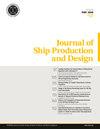考虑材料选择的折叠式舱盖优化设计研究
IF 0.9
4区 工程技术
Q4 ENGINEERING, MARINE
引用次数: 0
摘要
大多数造船厂公司为了生存,在业务的各个方面都保持效率。其中一个方面是船舶生产成本及其降低。本研究提出了一种使用优化方法来解决这个问题的方法。选择了一个由板和加强筋组成的舱口盖作为案例研究。在本研究中,使用Pareto方法和开发的优化方法,将舱口盖的质量和材料成本作为目标函数进行了优化。本研究选择板厚度t、加劲肋形状s和板材料类型m作为设计变量,同时考虑一些约束条件。为了估计最佳板厚度,使用优化技术开发了应力方程的表达式。此外,利用遗传算法对加劲肋形状和板料类型的选择进行了优化。结果表明,该优化方法能够有效地降低舱口盖的质量和材料成本。由于世界上几乎每个国家都受到经济危机的影响,对新造船业的需求都有所下降。造船厂公司必须创新思维,通过评估各种研究和即兴创造新方法来提高效率,从而在这场危机的压力下生存下来。其中一项研究考察了通过优化工作时间、工作流程生产系统和结构设计来降低船舶结构制造成本以保持盈利的方法。本文章由计算机程序翻译,如有差异,请以英文原文为准。
Study on Optimal Design of a Folding-Type Hatch Cover Considering Material Selection
Most shipyard companies maintain efficiency in all aspects of their business to survive. One of these aspects is ship production costs and their reduction. This study proposes a solution to this problem using an optimization method. A hatch cover composed of plates and stiffeners was selected as a case study. In this study, the mass and material cost of the hatch cover was optimized as an objective function using the Pareto approach with developed optimization methods. Plate thickness t, stiffener shape s, and plate material type m were selected as the design variables in this study along with some constraints. To estimate the optimal plate thickness, an expression of stress equations was Developed using an optimization technique. Furthermore, stiffener shape and plate material type selection were optimized using a genetic algorithm (GA). The results show that the optimization method is effective to decrease the mass and material cost of a hatch cover.
The demand for new shipbuilding has decreased because of the effect of the economic crisis that hit almost every country in the world. Shipyard companies must think innovatively and creatively to survive under the pressure of this crisis by evaluating various studies and improvising new methods to achieve efficiency. One of the studies that has been performed examines the methods to reduce the fabrication cost of ship structures to stay profitable through the optimization of work hours, workflow production systems, and structural design.
求助全文
通过发布文献求助,成功后即可免费获取论文全文。
去求助
来源期刊

Journal of Ship Production and Design
ENGINEERING, MARINE-
CiteScore
1.10
自引率
0.00%
发文量
19
期刊介绍:
Original and timely technical papers addressing problems of shipyard techniques and production of merchant and naval ships appear in this quarterly publication. Since its inception, the Journal of Ship Production and Design (formerly the Journal of Ship Production) has been a forum for peer-reviewed, professionally edited papers from academic and industry sources. As such it has influenced the worldwide development of ship production engineering as a fully qualified professional discipline. The expanded scope seeks papers in additional areas, specifically ship design, including design for production, plus other marine technology topics, such as ship operations, shipping economics, and safety. Each issue contains a well-rounded selection of technical papers relevant to marine professionals.
 求助内容:
求助内容: 应助结果提醒方式:
应助结果提醒方式:


